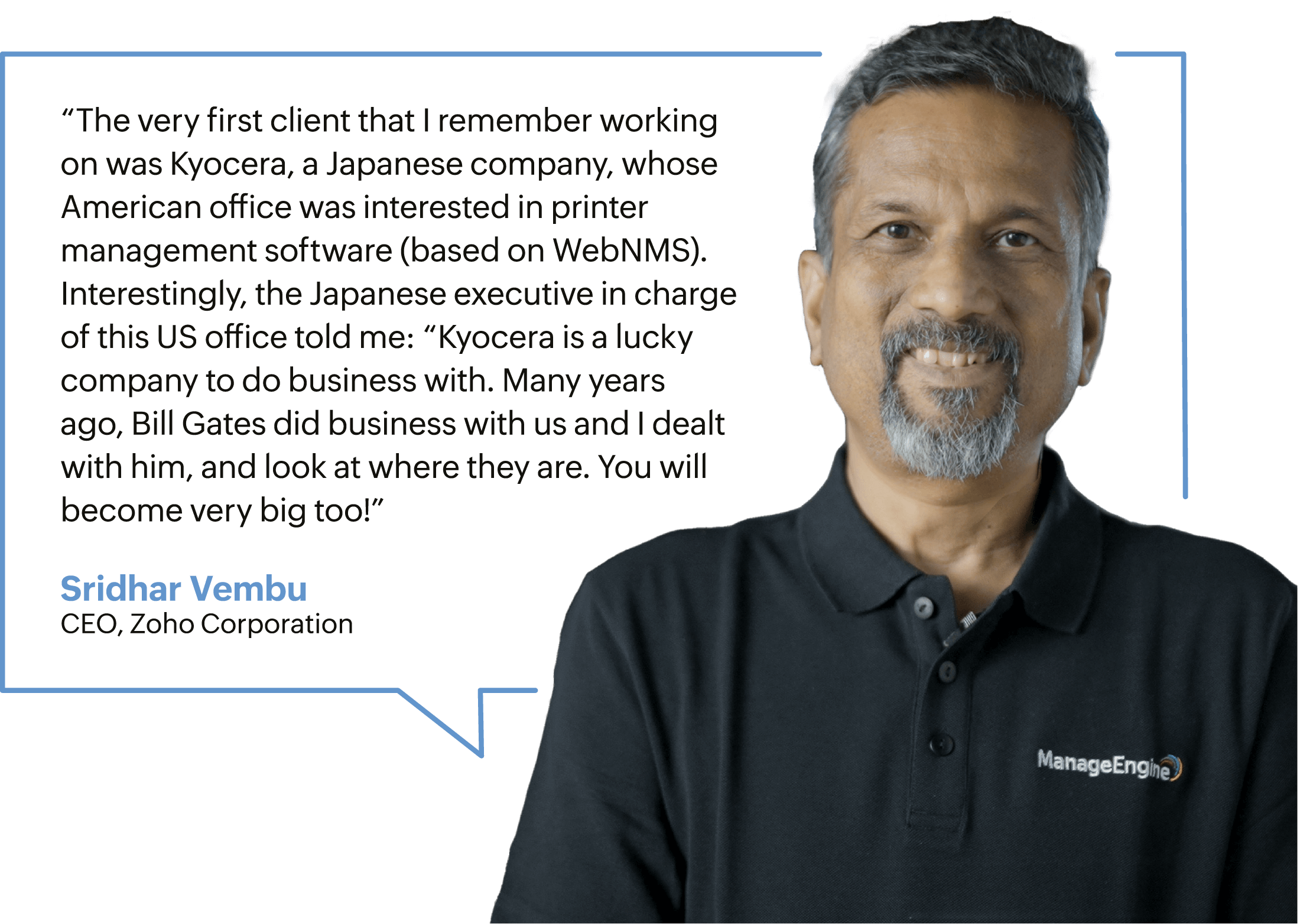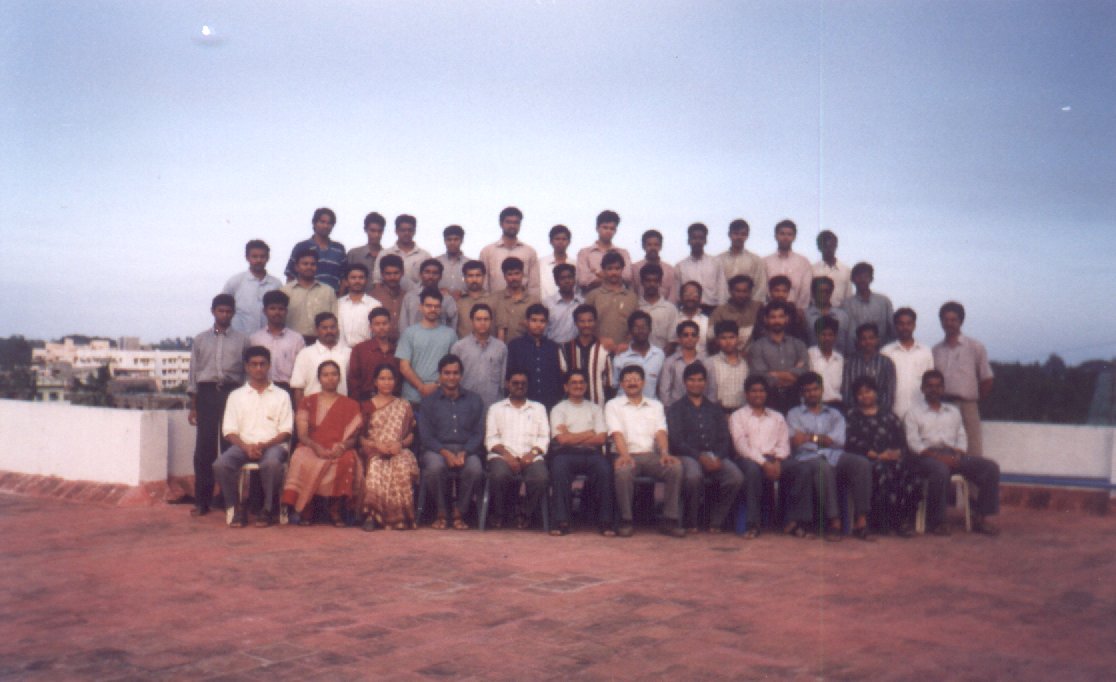Tale of two decades
The transformation story of ManageEngine into an IT enterprise
Introduction
The inner game
The wave of digital transformation has hit most organizations. "Digital" has become the buzzword when speaking of transformation of any organization, and IT leaders are going all-in on digital transformation, adapting to shifting trends and advanced technologies like AI and machine learning.
To us, real transformation—the kind that alters the way an organization operates at the cellular level—starts with building and sustaining energy across the organization. That's why we're focused on critical internal factors such as people, culture, business, and operating models that are fundamental to our transformation and success while digital assets remain enablers. We believe it's the only path that can help us sustain business during uncertain times and that it will pay off in the years ahead.
This e-book is a transformation story of ManageEngine from an ambitious start-up to a successful enterprise. We'll cover ManageEngine's inception story, the iterative journey of our business models (including the mistakes we made and the lessons we learned). It is based on internal interviews with our IT leaders and includes excerpts from Leadership Talks, a video series in which our leaders share their business journey, anecdotes, and best practices for small and medium-sized businesses (SMBs).
Chapter 1: The dot-com bubble burst and turbulent times
Humble beginnings
While ManageEngine is now known for IT management software, we did not start out with that intention. In 1996, the founding members of the organization joined hands to form Advent Network Management Inc. and started writing code in Java, an emerging platform at the time. They published Java SNMP API 1.0 (a reusable code) on the adventnet.com domain, which gained interest from software developers. For the next year, they worked to provide support and build more products on top of the original library. By late 1997 and early 1998, our software picked up in Silicon Valley and Advent Network Management was rechristened as AdventNet.
AdventNet had 15 members at the time of establishment and worked out of a modest 10x10 room in an apartment at the outskirts of Chennai, a metropolitan city in South India. The 90s saw a huge optical network boom that benefited the telecom industry and was also the period of Web 1.0 or the early stages of world wide internet, so our initial focus was on network management and providing software for businesses in this industry.
We also had a good market in Japan. Japanese companies would license our software, customize it, and ship it with their equipment. In fact, a top Japanese printer company wrote us our first big check. That's when our leaders knew AdventNet was a successful organization.

Tony Thomas was the first CEO of AdventNet, while Sridhar Vembu served as chief evangelist, working on promoting their new technology to the Silicon Valley and drumming up business. WebNMS, the first product of the organization, shipped OEM solutions such as protocol adapters, software agent, and test and simulation toolkits.
In 1997, AdventNet made about $350,000 in sales. However, the founders didn't pay themselves. They put almost all of it all back in research and development (R&D)—a move that would benefit us immensely in the years that followed. By 2000, Sridhar Vembu took on the role of CEO, and AdventNet was making millions in sales.
Around this time, the founders received an opportunity to join a venture capital fund. Sridhar was given a term sheet stating the organization must go for an IPO or generate liquidity in eight years. Despite being a standard clause, the idea of taking somebody’s money and promising them what they want did not sit right with him. The team decided to pass the offer and continue operating independently.

The dot-com burst and the struggles that followed
The rise of the internet in the late 90s led to the creation of multiple internet-based tech companies. Most of them didn't have feasible business models, yet investors funded these businesses purely based on speculation. This internet bubble expanded at an unprecedented rate until, ultimately, it burst.
By mid-2001, the market crashed and the telecom industry busted. One after another, network equipment companies funded by venture capital (VC) shut down or started layoffs. The bubble burst and the 9/11 attacks together pushed America to a recession, and its after effects were felt severely in Silicon Valley. Of the 500 companies in networking, only 4-5 of them survived—a 99% death rate.
Since we had sufficient funds (and a frugal mindset), we were prepared for the bubble burst and managed to stay afloat. However, losing customers made us question our future. We were profitable and we had the technology, the financial horsepower, and the eagerness to build more products. So, what next?
In 2002, we decided to move away from the network equipment market and address a bigger market: the enterprise IT market. By repurposing the existing technology and people, and building products for enterprise IT, we discovered untapped potential—that's how ManageEngine was born.
Lessons we learned early on
- Don't put all your eggs in one basket: One big customer shouldn't have the ability to make or break your quarter. Our target customers back then (and now) were SMBs and startups. Rather than investing big on enterprises, we actively chose to support upcoming businesses. When things got tough and our multi-million dollar, VC-funded customers left, we relied on a handful of SMBs who kept us going.
- Forget the titles: Establishing your presence in an ocean like Silicon Valley takes time. Our leaders have done everything from coding and sales to support and marketing, even if it didn't exactly fit their job descriptions. Titles mean nothing, they can change in an instant. Your skills, on the other hand, determine the growth trajectory for yourself and your organization.
- Be self-sufficient: Zoho Corporation is bootstrapped, which means we've never relied on third-party funding. Why does this matter? Being self-funded means we've chosen a path for ourselves that enables us to do what we do for customers without the influence of external decision-makers. While the lack of deep pockets may have slowed down our immediate growth, we're definitely reaping its benefits in the long run.
- Treat customers like partners: In the case of WebNMS, we were working with OEMs. These OEMs would then sell to service providers and so on, making us two to three levels removed from the actual end users. After the bubble burst, we realized, if you're closer to the customer, you're more stable. Moving forward, we knew we needed to foster deeper relationships with end users rather than being a resource.
- Always ask, "what else?": Technology is not the be all and end all. When we started, we had a product that was superior in terms of technology—something we thought would revolutionize the world. However, the technology didn't pick up. This was a case where we were betting a lot on one product and it didn't work out. Since then, we've learned to ask: if this doesn't work, what else will? ManageEngine offers a suite of products. It's a way for us to diversify into the market. If there's a specific market that is affected by an economic or tech crisis, we have other markets to serve. That keeps us relevant as a company.